
USS Iowa was a pre-dreadnought battleship built for the United States Navy in the mid-1890s. The ship was a marked improvement over the previous Indiana-class battleships, correcting many of the defects in the design of those vessels. Among the most important improvements were significantly better seaworthiness owing to her greater freeboard and a more efficient arrangement of the armament. Iowa was designed to operate on the high seas, which had been the impetus to increase the freeboard. She was armed with a battery of four 12-inch (305 mm) guns in two twin-gun turrets, supported by a secondary battery of eight 8-inch (203 mm) guns.

The seventh USS Washington (ACR-11/CA-11/IX-39), also referred to as "Armored Cruiser No. 11", and later renamed Seattle and reclassified CA-11 and IX-39, was a United States Navy Tennessee-class armored cruiser. She was laid down on 23 September 1903 at Camden, New Jersey, by the New York Shipbuilding Corporation, launched on 18 March 1905, sponsored by Miss Helen Stewart Wilson, daughter of United States Senator John L. Wilson of Washington state, and commissioned at the Philadelphia Navy Yard on 7 August 1906, Captain James D. Adams in command.
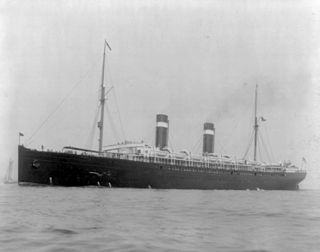
SS St. Louis, was a transatlantic passenger liner built by the William Cramp & Sons Building & Engine Company, Philadelphia and was launched on 12 November 1894; sponsored by Mrs. Grover Cleveland, wife of the President of the United States; and entered merchant service in 1895, under United States registry for the International Navigation Co., of New York City with her maiden voyage between New York and Southampton, England. She was acquired by the United States Navy during the Spanish–American War and commissioned under the name USS St. Louis in 1898, and again during World War I under the name USS Louisville (ID-1644) from 1918 to 1919. After she reverted to her original name in 1919, she burned in 1920 while undergoing a refit. She was scrapped in 1924 in Genoa.
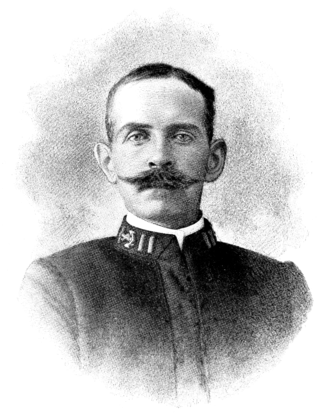
John Baptiste Bernadou was an officer in the United States Navy during the Spanish–American War. Born in Philadelphia, Bernadou graduated from the Naval Academy in 1880. He was promoted ten numbers for gallantry in action while commanding USS Winslow at the First and Second Battle of Cardenas, Cuba, from May 8 to May 11, 1898. John Baptiste Bernadou died at the Naval Hospital in Brooklyn, New York, on October 2, 1908, and is buried with his wife Florence Whiting in Arlington National Cemetery Section S. Div Site 2004 W.S

The second USS Marblehead (C-11/PG-27) was a Montgomery-class unprotected cruiser in the United States Navy, authorized in the naval appropriations bill of September 7, 1888. Marblehead served in the Spanish–American War and World War I, and was the last ship of her class in service.
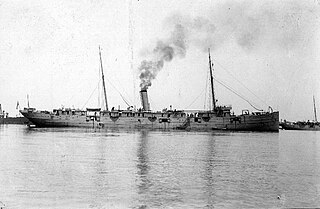
The first USS Yosemite was an auxiliary cruiser of the United States Navy. Built as El Sud in 1892 by Newport News Shipbuilding and Dry Dock Company, in Newport News, Virginia for the Southern Pacific Railroad's Morgan Line. The Navy acquired El Sud on 6 April 1898, at the beginning of the Spanish–American War and renamed her Yosemite. It commissioned her on 13 April 1898 under Commander William H. Emory.
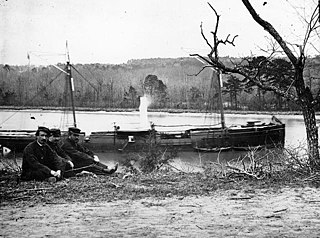
USS Kansas was a gunboat constructed for the Union Navy during the middle of the American Civil War. She was outfitted with heavy guns and assigned to the Union blockade of the waterways of the Confederate States of America. She was the first U.S. Navy ship to be named Kansas and was the first of a class of 836-ton screw steam gunboats. At war's end, she continued serving her country by performing survey work and defending American interests in Cuba until sold in 1883.

The first USS Annapolis (PG-10/IX-1) was a gunboat in the United States Navy. She was named for Annapolis, Maryland.

USS Porter was a torpedo boat, the first of her class, launched in 1896, served during the Spanish–American War, and struck in 1912. She was the first Navy ship named for Commodore David Porter, and his son, Admiral David Dixon Porter.

USS Wilmington (PG-8) was the lead ship in a class of two United States Navy gunboats. She was laid down on 8 October 1894 at Newport News, Virginia, by the Newport News Shipbuilding Company; launched on 19 October 1895; sponsored by Mrs. Anne B. Gray; and commissioned on 13 May 1897.

USS Hist, formerly Thespia, was built in 1895. She was purchased at Norfolk from David Dows, Jr., on 22 April 1898 for use in the Spanish–American War. Hist commissioned 13 May at New York, Lt. Lucien Young in command.

USS Topeka (PG-35) was a gunboat of the United States Navy.

The second USS Suwannee and third USS Mayflower was a United States Lighthouse Board, and later United States Lighthouse Service, lighthouse tender transferred to the United States Navy in 1898 for service as an auxiliary cruiser during the Spanish–American War and from 1917 to 1919 for service as a patrol vessel during World War I. She also served the Lighthouse Board and in the Lighthouse Service as USLHT Mayflower from 1897 to 1898, from 1898 to 1917, and from 1919 to 1939, and in the United States Coast Guard as the first USCGC Mayflower (WAGL-236) in 1939 and from 1940 to 1943 and as USCGC Hydrangea (WAGL-236) from 1943 to 1945.

Reina Mercedes, was an Alfonso XII-class cruiser of the Spanish Navy.
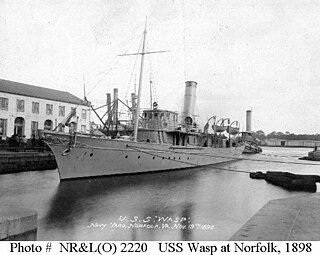
The seventh USS Wasp was the former yacht Columbia, purchased by the U.S. Navy and converted to an armed yacht serving from 1898 to 1919, with service in the Spanish–American War and World War I.

The Third Battle of Manzanillo was a naval engagement that occurred on July 18, 1898, between an American fleet commanded by Chapman C. Todd against a Spanish fleet led by Joaquín Gómez de Barreda, which occurred during the Spanish–American War. The significantly more powerful United States Navy squadron, consisting of four gunboats, two armed tugs and a patrol yacht, overpowered a Royal Spanish Navy squadron which consisted of four gunboats, three pontoon used as floating batteries and three transports, sinking or destroying all the Spanish ships present without losing a single ship of their own. The victory came on the heels of a more significant American success at the Battle of Santiago de Cuba, and was the third largest naval engagement of the war after Santiago de Cuba and the Battle of Manila Bay.

The fourth USS Scorpion was a steam yacht in commission in the United States Navy from 1898 to 1899, 1899 to 1901, and 1902 to 1927.

The action of 13 June 1898 was a minor naval engagement of the Spanish–American War fought near Cienfuegos, Cuba, between the American auxiliary cruiser USS Yankee under Commander Willard Herbert Brownson and the Spanish gunboat Diego Velázquez under Teniente de Navío de 1ª clase Juan de Carranza, which had exited the port to inspect a suspicious steamer which proved to be Yankee. Diego Velázquez, markedly inferior to Yankee in armament, managed to return to Cienfuegos, where it was joined by the small gunboats Lince and Cometa. After the appearance of the latters, Yankee decided to withdraw.

SMS Geier was an unprotected cruiser of the Bussard class built for the German Imperial Navy. She was laid down in 1893 at the Imperial Dockyard in Wilhelmshaven, launched in October 1894, and commissioned into the fleet a year later in October 1895. Designed for service in Germany's overseas colonies, the ship required the comparatively heavy armament of eight 10.5 cm (4.1 in) SK L/35 guns and a long cruising radius. She had a top speed of 15.5 kn.

USS Wompatuck (YT-27) was an armed tug in commission in the United States Navy from 1898 to 1931. Early in her naval career, she saw combat in the Spanish–American War and the Philippine–American War. After she was decommissioned, she was selected for conversion into the fuel oil barge YO-64, but she was lost in the early days of World War II in the Pacific before the conversion could be completed.




















